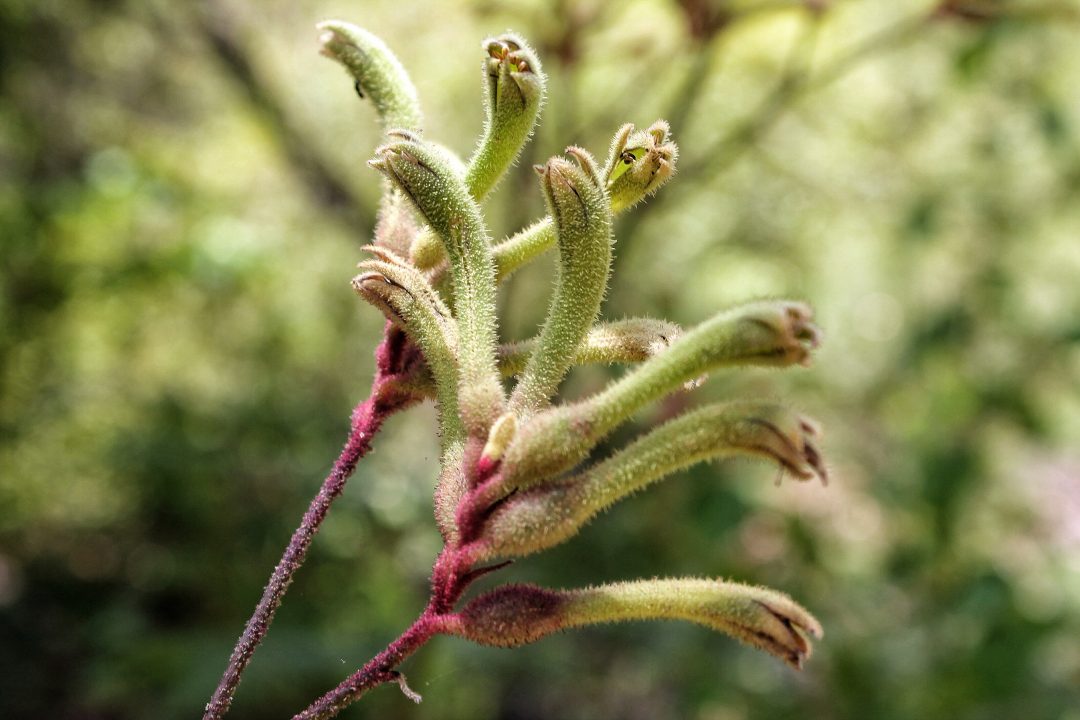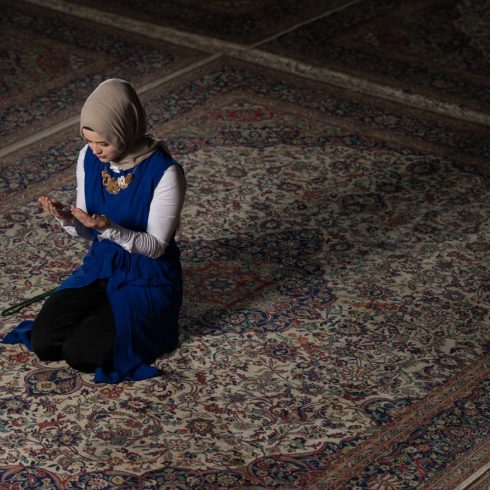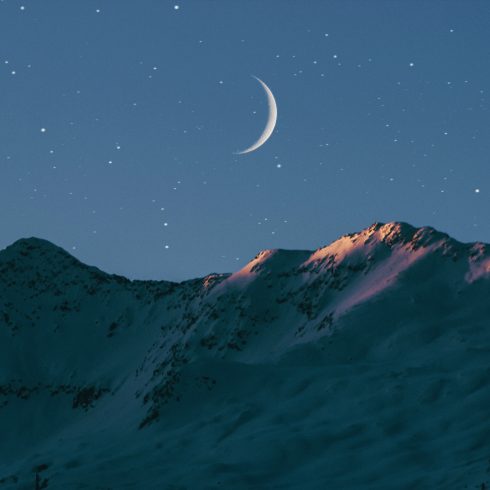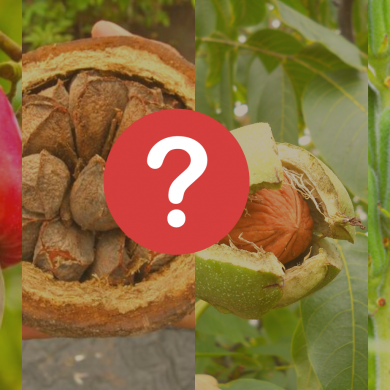Nature is the source of beauty in our life. Anytime someone wants to take a vacation distant from the constant stresses of everyday life, they will choose a destination with the most beautiful and peaceful scenery. If you think about all the beautiful rugs, patterns, paintings and architectural décor in the most stunning places, you will find the design is most often inspired by the intricate details of nature such as the leaves and the flowers. Even complex inventions are inspired by nature. For example, the aeroplane is inspired by Allah’s intricate and aerodynamic design of the bird, and the minute fibre strands of carpets are inspired from grass.
Truly, nature is a blessing to us from God. Seeing as this life is a constant test, God could have made the earth a dry and unpleasant place. Who are we to deserve the beauty that exists on this earth? In paradise, the splendid beauty is reserved for those who lived their lives as God ordained, and spent it doing good. However, in this world we sin, we rebel, we deviate; but despite all this Allah (swt) gives us the great gift of nature that puts our minds and hearts at ease. This is a great manifestation of God’s mercy on his creatures; for those of us who are truly good people we can enjoy this world and the next. Alhamdulillah(praise be to Allah) for this great gift and blessing that He has given us. Allah (swt) said:
وَالْأَرْضَ مَدَدْنَاهَا وَأَلْقَيْنَا فِيهَا رَوَاسِيَ وَأَنبَتْنَا فِيهَا مِن كُلِّ زَوْجٍ بَهِيجٍ
تَبْصِرَةً وَذِكْرَىٰ لِكُلِّ عَبْدٍ مُّنِيبٍ
“And the Earth, We spread it out, and cast therein firmly set mountains andWe have made to grow therein of all beautiful kinds; to give sight and as a reminder to every servant who turns to Allah.” [50:7-8]
and:
اللَّهُ الَّذِي جَعَلَ لَكُمُ الْأَرْضَ قَرَارًا وَالسَّمَاءَ بِنَاءً وَصَوَّرَكُمْ فَأَحْسَنَ صُوَرَكُمْ وَرَزَقَكُم مِّنَ الطَّيِّبَاتِ ۚ ذَٰلِكُمُاللَّهُ رَبُّكُمْ ۖ فَتَبَارَكَ اللَّهُ رَبُّ الْعَالَمِينَ
“It is Allah Who has made for you the earth as a place of settlement, and the sky as a canopy, and formed you and perfected your forms and has provided for you good things.” [40:64].
Sometimes when you’re feeling down, just one glance outside the window elevates your mood. Although Allah gives us many tests and difficulties in our life, He has also created so much beauty for us to dwell in and to enjoy.
Today I thought it would be interesting and fun to talk about just a few of the native species of Australia, as Australia is a beautiful country and the flora and fauna is has are like no other all over the world. As it says in the national anthem: ‘Our land abounds in natures gifts, of beauty rich and rare’. Australia has over 1 million different native species, and it is important that we are familiar with our environment so that we can appreciate it.
I picked some animals and some plants that are native to Australia and will give you a few fun facts about each one, and then there will be a quiz, so try to remember as much information that you can. Inshallah, I hope that after today we will all be able to appreciate the beautiful environment that Allah (swt) has created for us just a little bit more, through knowing how each individual creature has its amazingly unique characteristics, and hopefully you will have new knowledge that will make you enjoy the finer details whenever you are in nature.
Im going to start with some plants:
Common Pink Heath
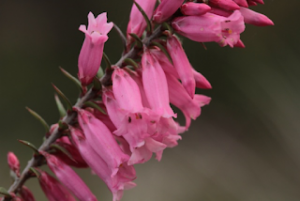 |
| Common Pink Heath |
The first is the common pink heath, which is actually a symbol of Victoria. This plant is a small shrub and can grow up to 1 metre in height. They can also be white or red, and its peak growth is in the wintertime.
Golden Wattle
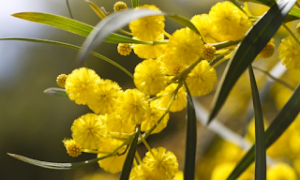 |
| Golden Wattle |
The golden wattle is Australia’s national flower, and is a large, yellow, fluffy plant. Each flower head is a bunch of tiny flowers, and it grows from 4 to 8 metres. Australia celebrates Wattle day on September 1st. The wattle is purpose built to cope with Australia’s rough weather. They have flattened stems instead of leaves to help withstand water loss in winds and droughts. In bushfires, the parent plants have a special survival mechanism in that the seeds have tough skins that open up in the heat of the fire. The plant’s resilience was one of the reasons it was chosen as Australia’s national floral symbol.
Bottlebrush
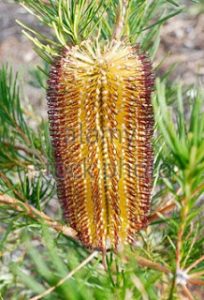 |
| Bottlebrush flower |
A bottlebrush flower is native to Australia and supplies nectar to many different birds. It is a beautiful flower and gets its name from its resemblance of a bottlebrush. SubhanAllah, it has such a unique shape.
Kangaroo Paw
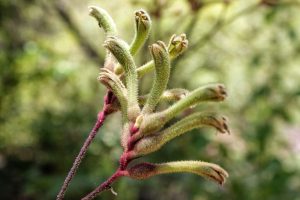 |
| Kangaroo Paw |
Kangaroo Paw – this one’s my favourite of them all. They are only found natively in western Australia and they flower all year round. It’s amazing how it actually looks like a real kangaroos paw, and has small hairs that give it a furry appearance. Nowadays, you can find this plant all around Australia. Apart from being fascinating, they can also be a bit scary if you look at it for too long…..
Eucalyptus tree
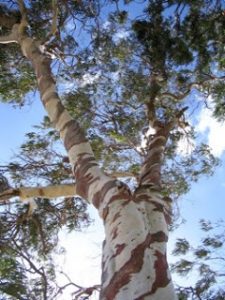 |
| Tall Eucalyptus tree |
The next plant is the Eucalyptus trees. These trees are quite common and are also very beautiful with their greyish trunks and light green leaves. They are amazing in that they can grow 90m in 90 years! The trees have a simple reason for growing tall; they are competing for light, which they use to photosynthesise and produce energy. The only thing that limits them from growing even higher is the fight for water, as pulling up water through the trunk is a process that goes against gravity, so in a sense, the top of the tree is like a small plant living in a dry place.
Some more facts: The tallest eucalyptus tree on earth is 99.6m tall. There are over 700 species in Australia. Leaves of eucalyptus has oil that is amazing for joints, bronchitis, other pharmaceutical uses, and even as an insecticide. Most trees shed their bark once a year. There is a species of Eucalyptus called the Rainbow eucalyptus. Patches of outer bark are shed annually at different times, showing a bright green inner bark. This then darkens and matures to give blue, purple, orange and then maroon tones.
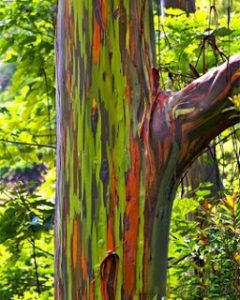 |
| Rainbow Eucalyptus |
The fruit of eucalyptus is a gum nut. Most can survive more than 250 years in the wild if not chopped by humans or burnt by bushfire. The oldest definitive Eucalyptus fossils are surprisingly from South America.
Starry Night
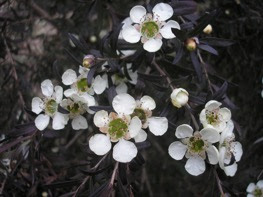 |
| Starry night plant |
This stunning plant has leaves which are a dark purple colour, which is so unique. Something I realised about Australian native plants is that often the leaves have colours quite different to the common bright green leaves. You see red leaves, orange leaves, red leaves, yellow leaves and purple leaves. The starry night is called this because when it flowers around summertime, it has small white flowers that look like stars among the dark leaves.
Now moving on to some animals:
Galah Cockatoo
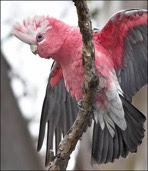 |
| Gala Cockatoo |
The Galah cockatoo can be easily identified by their grey back and pink chests and heads. They can grow up to 40cm long. The word gala comes from the term gilaa from the Yuwaalaraay language, an aboriginal language.
Gang-Gang Cockatoo
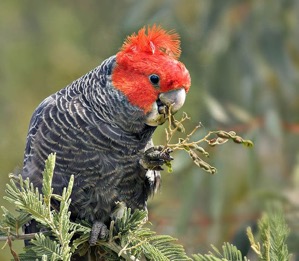 |
| Gang-gang cockatoo |
Next is the Gang-gang cockatoo. Only the male has this red head, the female is grey. They are mainly found in the Autralian Capital Territory, especially in Canberra.
Tasmanian Devil
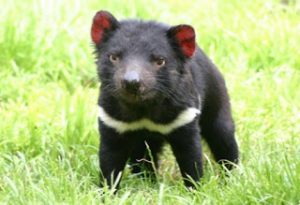 |
| Tasmanian Devil |
Tasmanian devil – called this because one of the early European colonists saw one at night where the blood had rushed to its ears so they were bright red and looked like a devil’s horn, and also due to the unpleasant sounds they make. They used to be common all across Australia, but now are only found in Tasmania. They are marsupials which means they have a pouch to carry their young. They are currently endangered due to an infectious facial cancer which they transfer to each other when they fight as they bite each other’s faces.
Although they are called devils, they are not very aggressive. They do not attack humans unless aggravated and are scavengers, meaning they only eat the meat of animals that have already died – they don’t kill them themselves.
Magpie
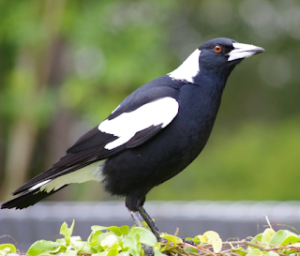 |
| Male Magpie |
Magpies have upper tail and shoulder patches which are white in males, grey in females. Across most of Australia, the remainder of the body is black. They can imitate the voices of other birds, horses, dogs and even human speech, and they are a highly intelligent species of bird. They are not very afraid of human and there has even been cases where they have wandered into open homes looking for food!
Sulphur-Crested Cockatoo
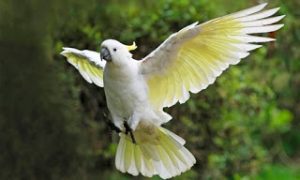 |
| Sulphur-Crested Cockatoo |
Another native Australian cockatoo is the Sulphur-crested cockatoo. They get their name from the yellow crest on their heads, as sulphur is a yellow colour. They are very loud and their screams can be heard up to 1 mile away. They can live up to 70 years old, and they make great pets.
Victoria’s Faunal Emblems
Finally, I wanted to talk about the two faunal emblems of Victoria, as that is most relevant to us.
The first one is the leadbeaters possum, which is currently an endangered species. An interesting fact I found is that they have a matriarchal society i.e. female dominated.
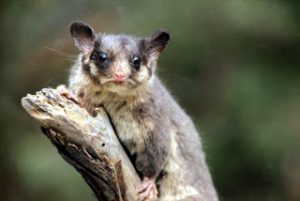 |
| Leadbeaters Possum |
The second emblem of Victoria is the Helmeted honeyeater. They have a beautiful colour and are termed ‘helmeted’ because of the yellow colour on their head. This bird is really rare and difficult to spot in the wild.
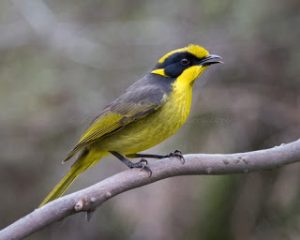 |
| Helmeted Honeyeater |
The above is a revised version of a speech given on Wednesday 21/2/18 as part of LAL’s first program for the year. There was also a fun quiz to test the audience’s memory at the end.
By Noor Alsaffar


